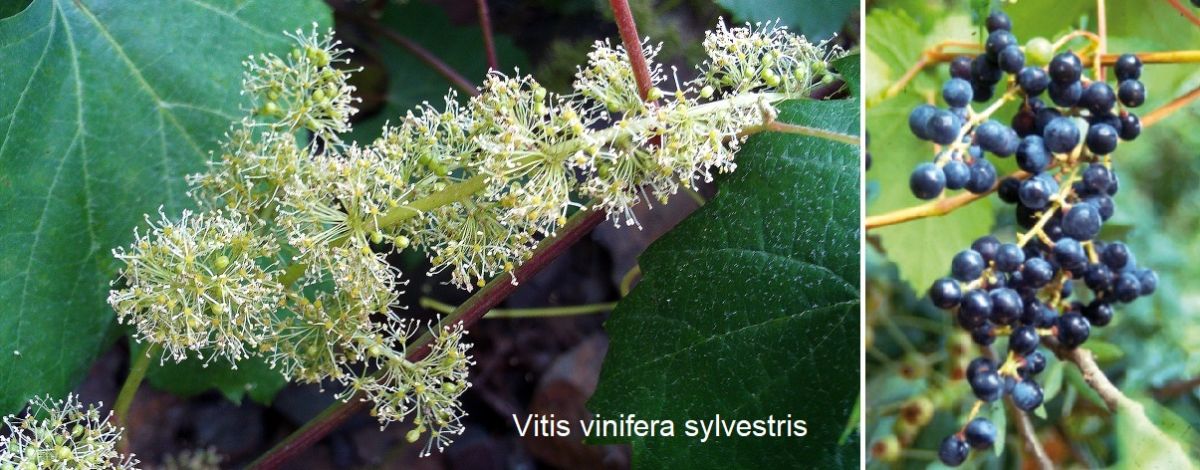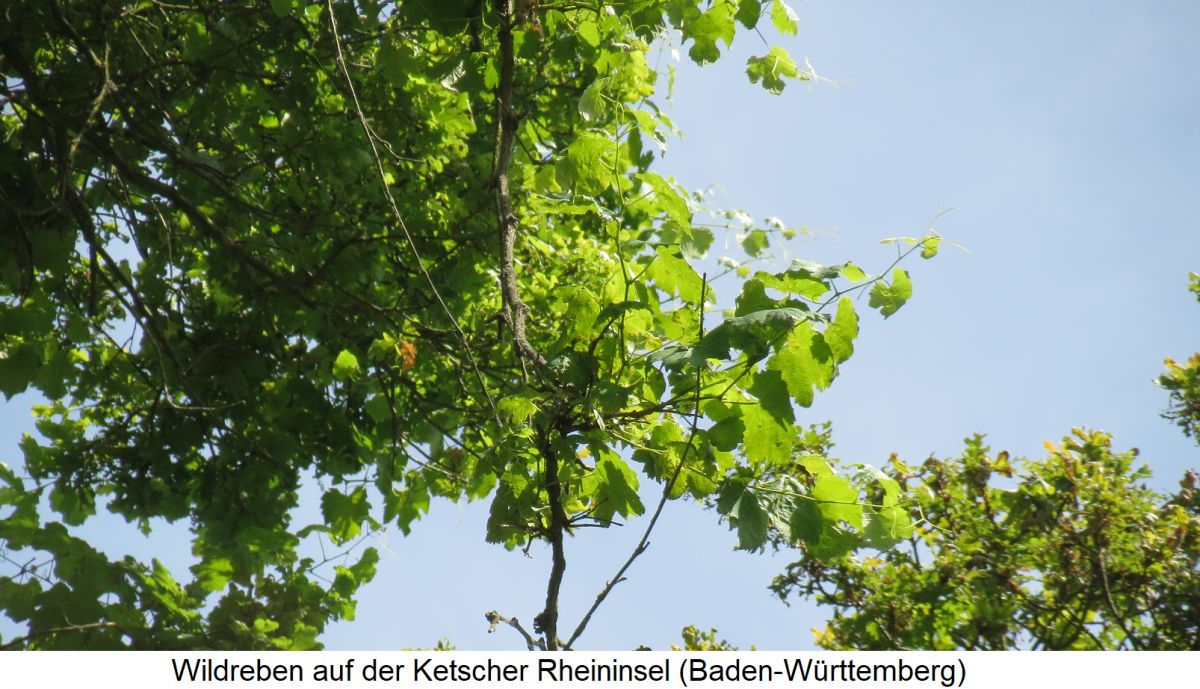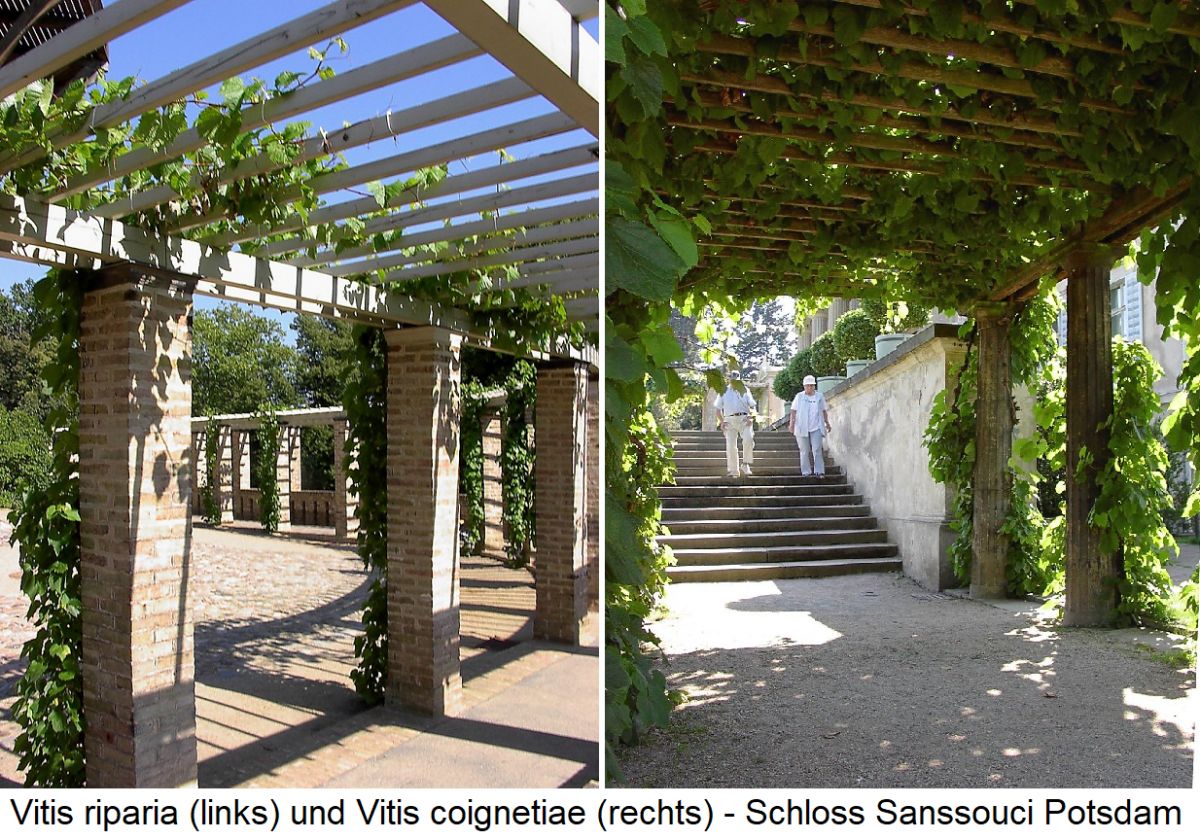Designation for natural vine occurrences that have evolved as species and subspecies in the course of a long evolutionary history. However, wild vines must not be confused with the vine genera known as wild gra pevines. The species ranges are a Spiegel of the climate and vegetation history of the respective colonisation areas and provide information about the adaptability of the species. Where the areas of different species overlap, viable natural hybrids have been able to develop through natural interbreeding. Based on the numerous finds of fossil seeds, wood remains and leaf imprints, it is considered proven that wild preforms of grapevines already existed at the end of the Cretaceous (Early Eocene) and in the early Quaternary (Oligocene), i.e. around 60 to 80 million years ago. The ice ages (100,000 to 10,000 years before today) pushed the wild vines native to Central Europe back into the Mediterranean region and the lowlands of the then non-existent Black Sea and into Central Asia.
Wild vines in Europe, Asia and America
One of the oldest descriptions of wild vines (besides those in the Bible) comes from the voyages of the Icelander Leif Eriksson in the Grenlinga saga, who reached the famous Vinland on the east coast of the USA (Massachusetts) around the year 1000. In the 17th century, European settlers in North America found lush wild vines growing in the forests. Today, there are still larger populations in the east and southeast of North America, as well as in Asia, especially in China.

Due to special climatic conditions in Europe, only Vitis vinifera has survived here as the only species. It is divided into the cultivated form Vitis vinifera ssp. vinifera (obsolete Vitis vinifera ssp. sativa) and the wild form Vitis vinifera ssp. sylvestris Gmelin. From this, the subspecies Vitis vinifera ssp. caucasica Vavilov was delimited, but this can no longer be reconstructed today. The latter two are named after the botanists Johann G. Gmelin (1709-1755) and Nikolai I. Vavilov (1887-1943). In contrast, there are the large groups of Asian v ines and American vines, each with around 30 species.
Development in Europe
During the periods of interglacial warm periods, new vine populations repeatedly formed in Central Europe, only to be wiped out again by subsequent ice ages. After the end of the last ice age about 10,000 years ago, during the following warm period (5500 to 2500 BC) with its subtropical monsoon climate, wild vines also returned to Central Europe together with other woody species. The large-scale spread was mainly due to birds, which ate the berries together with the seeds and excreted the indigestible seeds somewhere with the bird droppings. In the floodplains, flooding also contributed to the spread. In this way, new wild vines were able to spread in the mixed oak forests and riparian forests, which were much thinner at the time.
Together with the tree species advancing northwards, wild vines must have spread over large areas as far north as the forest line was about 200 m higher than today. In the sparse mixed oak forests, wild vines occurred in bush form or grew up to 20 metres high on emerging trees. They probably lived to be as old as their supporting trees, i.e. to be about 80 to 300 years old. From about 2500 BC onwards, the climate deteriorated noticeably and during this cooler phase, dark closed beech forests established themselves as the dominant forest formation in Central Europe from 1800 BC onwards. As a result, the European wild vine populations were pushed back to the large river floodplains, because in the extremely shady and long-lived hall forests (without ground cover) formed by the beech or in the now significantly cooler mountain forests, nascent seedlings no longer had sufficient growing and living conditions.
However, reproductive populations survived in thousands of specimens in the clear floodplains of the large river valleys of the Danube, Rhine, Rhône and their tributaries. Only there did the annual floods create a dynamic and structurally rich vegetation mosaic consisting of the most diverse stages of plant communities. In the clearings that were constantly being created, with burgeoning shrub growth and natural tree regeneration, the light- and heat-loving lianas were offered optimal conditions for growth and climbing. In addition, the deposited mud created the ideal germination bed for seed germination. In more southerly regions, it was also the river valleys that were able to offer the vines sufficient water, light and settlement dynamics in the face of increasing drought.

Due to clearing towards the end of the 19th century, planting of forests, targeted removal of wild vine thickets, as well as extensive river straightening and draining of riparian forests, they are almost extinct in Europe today. There are still some remaining populations in Spain (Basque country), France (on the banks of the Garonne, Loire and Rhône), in Germany (on the upper reaches of the Rhine), in Switzerland (Lake Geneva), in Austria (in the Lobau floodplain near Wien), in the Balkans and on the Danube, especially in Serbia and Romania. On the Ketscher Rheinisel (a nature reserve) west of the municipality of Ketsch in Baden-Württemberg is the largest stand of wild grapevine Vitis vinifera subsp. sylvestris in Germany.
Differences between wild and cultivated vines
If a wild vine is cultivated and trained and pruned like a cultivated vine, the difference between cultivated and wild vines is not that great. The most significant difference is the so-called dioeciousness, i.e. the vines of wild vines bear only functionally male or only functionally female flowers and are thus dependent on cross-fertilisation. However, there are still some functionally female cultivated grapevine varieties, and about 1 to 5% of wild grapevines in still existing stands bear hermaphrodite flowers. The rule in wild grapevines, however, is dioecious plants with unisexual flowers, blue berries, elongated internodes and long functional tendrils. The monoecious cultivated vines usually bear hermaphrodite flowers (see also in detail under flowering).
Other characteristics of wild grapevines are relatively small, loose-berried clusters and small berries with comparatively large seeds, although the clusters of some species can certainly compete with small-berried Central European varieties. Also genotypically, a distinction between European wild grapevine and European cultivated grapevine can hardly be made clearly. In the case of wild species, however, we do not speak of varieties but of forms and often use the collector, place of collection and numbers instead of euphonious names. Two such forms are Vitis vinifera ssp. sylvestris Ketsch 7 (after the place of discovery Ketscher Rheininsel in Baden-Württemberg) and Vitis cinerea Arnold (after the American botanist Charles Arnold).
Most likely, however, the remaining wild vine stands can no longer be considered original. Due to geographic isolation and tiny population sizes, the remaining central and southern European occurrences show incest phenomena on the one hand, which are expressed genotypically in an increased degree of homozygosity (hereditary equality) of the alleles. On the other hand, some of these are already plants into which genes from cultivated vines or hybrid varieties may have spontaneously crossed through pollen flight from neighbouring vineyards. The similarities between Rhenish wild vines and old cultivated varieties such as Pinot Noir, Riesling or Traminer should therefore not be misinterpreted. Presumably, these similarities are not due to selection from wild vine stocks or spontaneous cross-breeding of wild vine pollen into cultivated stocks. Rather, the cultivated stocks are likely to have crossed into the wild vine stocks.
Development of grapevine varieties
Spontaneous (natural) formation of new varieties without human intervention still takes place today. Traces of hybrid vines of the American species Vitis labrusca, Vitis riparia or Vitis rupestris, which were once used as rootstocks, are often found. Favoured by resistance to fungi, some could develop into new hybrid vines. Obviously, hybrid genes have already crossed into some European wild grapevines, because alleles are found in the genotypic profiles of some wild grapevine populations of the Rhine and Danube that otherwise only occur in American grapevines, but cannot be detected in any of the old European varieties. Wild grapevine populations are subject to natural evolution and selection. Therefore, they are often characterised by increased resistance to native diseases or negative environmental influences. Indeed, most American wild species have developed defences against phylloxera and both types of powdery mildew, while Asian vines have had to survive low frost temperatures.
The wild European vines, on the other hand, did not have to develop such resistances because until the middle of the 19th century there was no selection pressure for phylloxera or powdery mildew resistance and the frosts in the low-lying river valleys were not as severe. Today's remaining populations, with the exception of the still larger stocks on the lower Danube, are hardly capable of active reproduction due to tiny numbers and more difficult germination conditions. Without reproduction, these already overaged populations are inevitably doomed to extinction at the natural sites, so that evolutionary adaptation processes to new pests can no longer be expected from there. For this reason, resistant wild species from America and Asia are still used today in resistance breeding as gene donors for fungus-resistant new varieties.
Historically, the first cultivated grapevine varieties probably originated from wild forms that survived on the Caucasus rim about 7,500 years ago, from which the cultivated grapevine varieties that still exist today have developed over thousands of years through selection, further crossing, renewed selection and targeted or spontaneous cross-breeding. It is not known when targeted breeding (crossbreeding) began in the past. Grape seeds found in Asia Minor prove that wild grapes were collected and used by Stone Age people as early as 9,000 years ago. The actual domestication, i.e. the cultivation of cultivated varieties for wine production, probably began six to eight thousand years ago in Transcaucasia on the southern edge of the Caucasus and in Mesopotamia. According to the latest research, the cultivation of vines with cultivated varieties originated in south-eastern Anatolia not far from Mount Ararat in present-day Turkey.
Spread of cultivated vines
From there, viticulture spread westwards (Anatolia, Mediterranean, Balkan/Donau countries) and southwards (Mesopotamia, Jordan Valley, Egypt) and eastwards (Iran, Afghanistan, China), where wine culture was refined by the ancient advanced civilisations of the Egyptians, Assyrians, Babylonians, Hittites, Persians and Sumerians. Presumably, in each historical cultivation area, new varieties have repeatedly emerged at different times through seedling sowing and selection. Certainly some of these ancient grape varieties were introduced to southern Europe by Alexander the Great (356-323 BC) and others perhaps before him, and were cultivated and propagated by the Greeks, Phoenicians and Romans. It is likely that the Indo-European peoples of the Celts in Gaul and the Balkans already had regionally climate-adapted varieties for viticulture long before the Roman Empire was established. Bronze Age long-distance trade contributed to the general spread of grape varieties from Asia Minor and the Mediterranean.
Wild grapevines, as already mentioned, are usually dioecious. To produce fruit on female plants, pollinator plants are needed in the neighbourhood. Presumably, the rare cases of hermaphrodite and large-flowered female plants in the wild vine populations were deliberately selected and cultivated in the gardens together with imported varieties, possibly crossed with each other in early times and sown again until more productive varieties with hermaphrodite flowers were bred. The hermaphrodite flowers make the cultivated vine a self-fertiliser, which ensures a regular yield. Today, the varieties of the cultivated vine Vitis vinifera ssp. vinifera include almost only hermaphrodite and some old female varieties. Today, wild vines are often used as ornamental vines on walls or pergolas. The pictures show American (Vitis riparia) and Asian species (Vitis coignetiae) in the Sanssouci Palace in Potsdam (Brandenburg).

Perhaps the all-female grape varieties still preserved in large quantities in the Balkan region are eloquent testimony to this perhaps already very old breeding tradition. However, targeted fertilisation of mother varieties with pollen of selected father varieties, subsequent sowing and seedling selection are only documented in writing from the middle of the 19th century, initially for England and France, later increasingly for the whole of Europe. It is probable that the ancient civilisations mentioned above were already engaged in selective cross-breeding and that the Romans took over the knowledge, but after the collapse of the Roman Empire at the latest, this knowledge, which was probably never recorded in writing, was unfortunately lost during the turmoil of the migration of peoples and in the anti-scientific Middle Ages.
further information
For more information on this subject, see also Ancient grape varieties and Grapevine systematics. For a comprehensive list of relevant keywords on the subject of grapevine, see the keyword Grapevine.
Vitis vinifera sylvestris on the left: By Javier martin - Own work, Public domain, Link
Vitis vinifera Sylvestris right: Vine to Wine Circle
Wild vines Rhine Island: By AnRo0002 - Own work, CC0, Link
Sanssouci Palace: FassadenGrün
Voices of our members

The Wine lexicon helps me to keep up to date and refresh my knowledge. Thank you for this Lexicon that will never end in terms of topicality! That's what makes it so exciting to come back often.
Thorsten Rahn
Restaurantleiter, Sommelier, Weindozent und Autor; Dresden